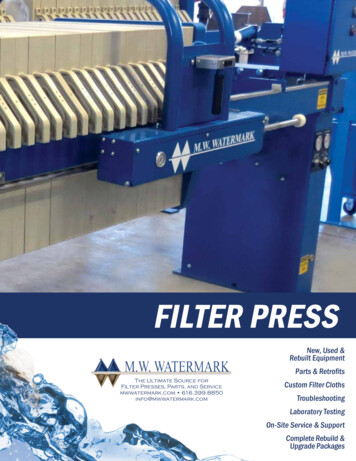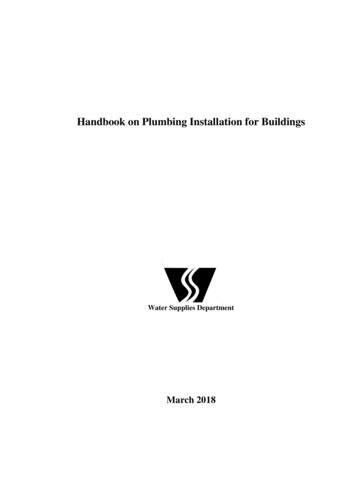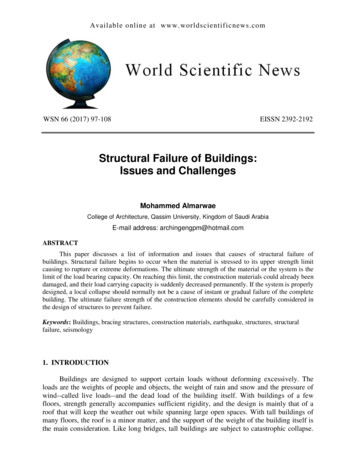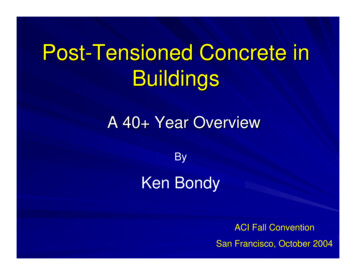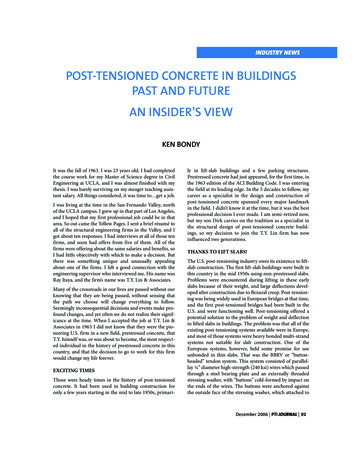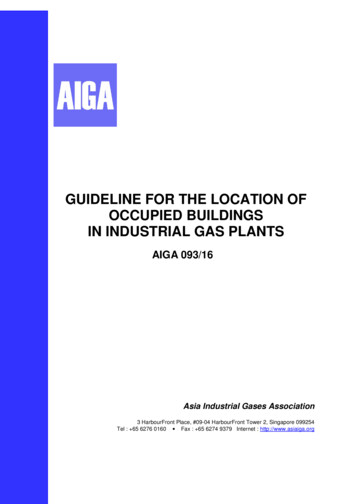
Transcription
Process Equipment Buildings:Manageable Risk or Danger Lurking forSynthetic Gas Processes?Timothy Melton, Ph.D., P.E., Chief Consultant with JCL Risk Services (Primary)Kay Modi, Senior Process Safety Consultant with JCL Risk Services (Secondary)Presented: April 18, 2018SynGas AssociationProducers & Suppliers of the Synthetic Gas Industry*
Process Equipment Buildings: Manageable Risk or DangerTABLE OF CONTENTS1.0INTRODUCTION . 32.0REQUIREMENTS TO PERFORM FACILITY SITING STUDIES . 33.0WORST CASE IMPACTS, MAXIMUM CREDIBLE EVENT . 44.0SIDE-ON OVERPRESSURES . 45.0VAPOR CLOUD EXPLOSION PHENOMENOLOGY. 65.1Reactivity. 65.2Congestion . 65.3Confinement . 75.4Confined Explosions . 76.0PROCESS EQUIPMENT BUILDING HAZARDS . 87.0PROCESS EQUIPMENT BUILDING VENTILATION. 108.0OTHER CONCEPTS RELATED TO THIS DOCUMENT . 10APPENDIX A: REFERENCES . 11APPENDIX B: AUTHORS . 12Page 2 of 13
Process Equipment Buildings: Manageable Risk or Danger1. INTRODUCTIONHydrogen is a primary product in synthetic gas processes. The impacts of hydrogen releases andpotential fire and explosion in these process areas vary depending on several factors. OSHA’srequirement to study these impacts has revealed many unintended consequences during JCL RiskServices’ Facility Siting studies especially when reviewing enclosed processes containinghydrogen gases.There are many reasons that facilities construct buildings around process equipment. Operatorsmay work more efficiently when working out of the heat of the sun or cold of snow and blowingrain. Process equipment may be subject to freezing or overheating when exposed to extremes ofclimate. A building or shelter of some type may seem like a relatively inexpensive way to moderateconditions surrounding the equipment for operational or operator concerns.An important side-effect of enclosing process equipment, however, is the creation of a confinedenvironment that will enhance the severity of any flammable cloud ignition and could turn arelatively minor process upset or release into a devastating facility-impacting catastrophe. Carefulexamination of the nature of the flammable materials in the synthetic gas processes and thecharacteristics of the building protecting the equipment can lead to the identification of potentiallysevere explosion hazards and suggest methods that may be used to reduce or eliminate thedanger posed to operators and other equipment at the facility.Our presentation will cover these subjects and provide examples of the hazard mitigationrecommendations that JCL Risk Services has presented to operating companies.2. REQUIREMENTS TO PERFORM FACILITY SITING STUDIESThe Occupational Safety and Health Administration’s (OSHA) Process Safety Management (PSM)regulations require facility siting evaluations to address the safety of building occupants. The PSMregulations require the use of Good Engineering Practice (GEP) which leads most companies touse the recommended methods and practices from the Center of Chemical Process Safety (CCPS)and from the American Petroleum Institute (API) Recommended Practices 752 and 753. Thesereferences are compatible in technical approach in order to be certain that occupants are safewithin buildings in and near industrial sites that are required to comply with PSM.These studies are commonly referred to as building or facility siting evaluations and they requireboth an understanding of the process impacts due to fires, explosions, and toxic releases and ofthe structure of buildings with occupants (control rooms, administrative buildings, maintenancebuildings and other occupied structures). Refer to the references listed for more information.The primary purpose of our paper is to illustrate some important concepts found in the SyntheticGas industries due to the presence of hydrogen.Explosions associated with hydrogen are among the largest in industry even though the explosionsmay not be the most common. Hydrogen has an impact more than five (5) times the explosiveforce for the same industrial conditions if the release was ammonia or natural gas. Instead of anexplosion force that nearby buildings could withstand if natural gas or ammonia releases havedelayed ignition, a hydrogen explosion can create very high explosive forces that most buildingscannot withstand resulting in a high probability of fatalities.The results of facility siting evaluations can be surprising for many facilities due to themisunderstanding of past studies under representing the presence of hydrogen. Facilities shouldbe aware of enclosing any process or equipment that contains hydrogen due to severemagnification of the explosion and the increased possibility of accumulated gas within the enclosedstructures (such as compressor buildings and process control skids).Page 3 of 13
Process Equipment Buildings: Manageable Risk or Danger3. WORST CASE IMPACTS, MAXIMUM CREDIBLE EVENTWhen evaluating the worst-case impacts on an occupied building, the maximum credible event isconsidered. This MCE is the release event that has the largest possible consequence that isphysically possible. The probability of this even occurring is not a factor at this stage, only the factthat it is physically possible. An example of a maximum credible even for a large iso-butylenesphere would be the guillotine failure of the largest line feeding the sphere. Physically impossiblescenarios, such as the sudden disappearance of the containing sphere are not credible and notconsidered. If the consequences of the maximum credible event are unacceptable, a risk-basedapproach may be used to incorporate the likelihood of the event occurring in practice. The eventswe will examine in this paper are only the maximum credible events. The more frequent, smallleaks or fugitive emissions are generally mitigated by the basic ventilation systems of a processbuilding. Maximum credible events can easily overwhelm building ventilation and causecatastrophic damage if they occur.4. SIDE-ON OVERPRESSURESFor screening existing occupied buildings, peak side-on overpressure is the parameter that is usedto determine the potential threat to personnel. New buildings should be designed using moredetailed analyses that include the impulse or positive phase duration of the potential overpressureexposure. Overpressure levels of interest in screening existing occupied buildings are given inFigure 1 below along with their typical consequences found in Table 1 on the following page.Figure 1: Incident Overpressure Damage to a Medium Metal Structurewith noted Hydrogen and Methane VCE Values(Figure 7 from “APPROVED METHODS AND ALGORITHMS FORDOD RISK-BASED EXPLOSIVES SITING”)Page 4 of 13
Process Equipment Buildings: Manageable Risk or DangerTable 1: Overpressure Levels of Interest in Typical Building Siting StudyPeak Side-OnOverpressure,psigBuilding or Asset ConsequencesOccupantConsequence0.6Light Wood Trailer is damaged in localized areas. Windowbreakage and falling overhead items are expected. Studs onthe reflected wall (the wall facing the explosion) are expectedto crack but remain in place.Injury to personnelunlikely0.9Light Wood Trailer damage is widespread, but structuralcollapse is not expected. Wall components facing the blastsustain major damage and may fail. Window breakage andfalling overhead items are expected.Possible injury fromflying glass, lightfixtures1.0Possible minor structural damage to buildings and severedamage to trailer-type buildings and unreinforced masonryload-bearing wall buildingPersonnel injury fromdebris is likely2.0Local failure of isolated parts of buildings and collapse oftrailer-type buildings and unreinforced masonry load-bearingwail buildingPossible seriousinjury or fatality ofsome occupants3.0Collapse of buildings (brick and metal structures)Damage to cooling towersProbable seriousinjury or fatality ofmany occupants5.0Potential rating of blast resistant modules for control rooms.Between 5 psi overpressure and 12.0 psi overpressure:overpressures could be sufficient to cause connection failuresor frame damage to horizontal pressure vessels and causeconnection failures in typical heat exchangersProbable seriousinjury or fatality ofmany occupants10.0Probable total destruction of non-blast-resistant buildings andsignificant damage to blast resistant buildingsProbable 100%fatalities 12.0Blast overpressure will be sufficient to cause horizontalpressure vessels and typical heat exchangers to overturn orbe destroyed and cause vertical pressure vessels to be movedenough to cause connected piping to fail. Depending on thepeak overpressure attained, blast overpressure may besufficient to overturn or destroy vertical pressure vessels aswell. High level of concern for a “domino effect” with extensivedamage to the surrounding areas as additional releases offlammable materials lead to numerous VCE events in otherareas of the facility.Probable 100%fatalitiesThe models typically used to predict the overpressure consequences for vapor cloud explosions inbuilding siting calculations are the Baker-Strehlow-Tang (BST) model and the TNO Multi-Energymodel. JCL Risk Services uses the Multi-Energy model blast curves to predict the explosionconsequences and uses a hybrid of several techniques to characterize the severity of theexplosion.Page 5 of 13
Process Equipment Buildings: Manageable Risk or Danger5. VAPOR CLOUD EXPLOSION PHENOMENOLOGYA vapor cloud explosion (VCE) occurs when a fuel-air mixture ignites and generates a pressurewave due to the expansion of the products of combustion. If the products of combustion are allowedto expand at a constant pressure, the final volume they will occupy is typically five to eight timesthe initial volume. In the real world, the combustion gases will not be free to expand withoutrestrictions and most buildings that might contain combustible mixtures will not be strong enoughto contain the maximum pressure that could theoretically be generated. The actual pressureexperienced will be a function of the strength of the building, the manner in which the building fails,the nature of the exploding fuel-air mixture, and the geometry of the interior of the building and thebuilding’s surroundings.The overpressure produced by a propagating flame front is directly related to the velocity ofpropagation of the flame through the unburned mixture. Low flame speeds generate very lowoverpressure while faster flames generate much higher overpressures. Flames propagating belowthe speed of sound in the unburned fuel-air mixture are referred to deflagrations while flamespropagating at speeds greater than the speed of sound are called detonations. Deflagrations mayspeed up or slow down as the environment of the flame changes. As an initially slow flameaccelerates, it may accelerate to the point that it becomes a detonation. This process is called adeflagration-to-detonation transition (DDT). A detonation will continue to propagate as a detonationuntil it has consumed all of the flammable gas mixture available regardless of the surroundings orcongestion or lack thereof.There are three factors that influence the speed of a propagating flame: reactivity of the fuel,congestion or obstacles in the flow field, and confinement of the flammable mixture. Each of thesefactors and how they are characterized in appropriate models is discussed in the following sections.5.1. ReactivityFuel reactivity is a measure of the propensity of the flame front in a given flammable mixtureto accelerate and create overpressures or potentially undergo a deflagration-to-detonationtransition (DDT). Reactivity is typically classified as high, medium, or low based on thelaminar flame speed of the fuel-air mixture. These categories have been given boundaries,effectively placing certain materials in each category. Ammonia and pure methane areclassified as low reactivity materials. Hydrogen is classified as a high reactivity material. Mostother common industrial gases (e.g., propane or butane) are classified as medium reactivitymaterials.Table 2: Comparison of Hydrogen, Methane, and Ammonia Flame CharacteristicsGasReactivity Class Flammable Range, volume % Laminar Flame Speed, cm/sAmmoniaLow15 - 287MethaneLow5 - 1540HydrogenHigh4 - 753125.2. CongestionCongestion is usually characterized by the density of obstacles in the explosion flow field,either based on the percentage of the viewed area blocked by obstacles (area blockage ratio)or the percentage of a given volume that is occupied by obstacles (volume blockage ratio).The size and configuration of obstacles will also affect the flame acceleration. A congestedregion with smaller obstacles will generate higher flame accelerations and consequentlymore severe explosions than a region with larger o
02.04.2018 · and from the American Petroleum Institute (API) Recommended Practices 752 and 753. These references are compatible in technical approach in order to be certain that occupants are safe within buildings in and near industrial sites that are required to comply with PSM. These studies are commonly referred to as building or facility siting evaluations and they require both an understanding

